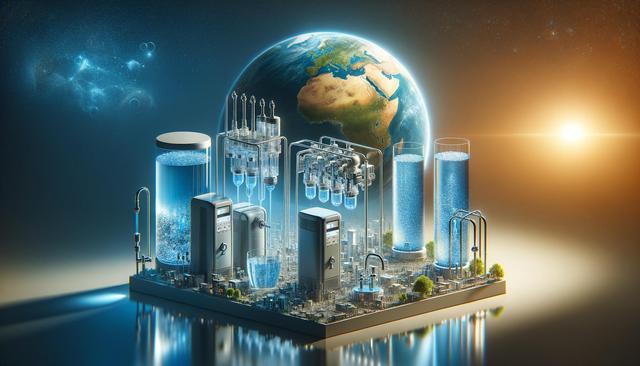Advancements in Water Purification Technology
In 2025, water purifiers and filters have seen significant innovations, driven by the global need for safer, more accessible drinking water. The latest systems incorporate advanced filtration technologies such as nanofiltration, ultraviolet (UV) sterilization, and reverse osmosis (RO) with improvements in energy efficiency and sustainability. These methods are more precise in removing harmful contaminants such as heavy metals, bacteria, viruses, and microplastics.
Another notable advancement is the integration of smart technology into home water purifiers. Many modern systems now come equipped with sensors and real-time monitoring features. These allow users to track water quality and filter performance through smartphone apps, ensuring timely maintenance and filter replacements. This integration not only boosts convenience but also enhances the reliability of the purification process.
Some of the newer purification models also use environmentally conscious materials and processes. For instance, reusable filter cartridges and biodegradable components are becoming more common. These sustainable designs align with a broader push toward reducing single-use plastic and minimizing environmental impact.
Types of Water Purifiers and Their Applications
There are several types of water purifiers and filters available in 2025, each catering to different needs and environmental conditions. Understanding these options helps consumers choose the most appropriate system for their homes or businesses.
The most common types include:
- Reverse Osmosis (RO) Systems – Ideal for removing dissolved salts, heavy metals, and chemical contaminants.
- Ultraviolet (UV) Purifiers – Effective in killing bacteria and viruses without altering the taste of water.
- Activated Carbon Filters – Known for eliminating chlorine, odors, and organic compounds.
- Gravity-Based Filters – Popular in areas with unreliable electricity, using natural pressure to purify water.
- Multi-Stage Purifiers – Combine several filtration methods for comprehensive purification.
These systems can be installed for residential, commercial, or portable use. From under-the-sink units to countertop filters and central water systems, the range of available products continues to grow, offering flexible solutions for various water quality challenges.
Health and Safety Considerations
Ensuring the safety of drinking water remains a top priority in 2025. Water purifiers and filters play a critical role in preventing waterborne diseases and exposure to harmful substances. However, not all systems are equally effective. Consumers are advised to assess water quality in their area before selecting a filtration system, as different contaminants require different purification methods.
Water testing kits are now more accessible and affordable, allowing users to determine the presence of pollutants such as arsenic, lead, nitrates, and microbial pathogens. Based on these results, a suitable purification system can be chosen to address specific concerns. For example, areas with high microbial contamination may benefit more from UV purification combined with carbon filters.
Proper maintenance is also vital for health and safety. Filters that are not replaced in time can become breeding grounds for bacteria. Many modern systems now include indicators or app-based alerts to notify users when maintenance is required. This proactive approach helps to ensure consistent water quality and reduce health risks.
Environmental Impact and Sustainability
With growing environmental awareness, the water filtration industry in 2025 is increasingly focusing on sustainability. Traditional water purification methods often involve significant waste, particularly in the form of discarded filters and plastic components. Newer systems aim to reduce this impact through innovative design and materials.
For example, many manufacturers are now producing reusable filter cartridges that can be cleaned and reinserted, reducing the frequency of replacements. Others have introduced biodegradable filter media that decompose naturally after use. Additionally, energy-efficient purifiers are becoming more common, helping to lower household energy consumption.
Consumers can also make environmentally conscious choices by selecting systems that minimize water wastage. Some traditional reverse osmosis systems discard several liters of water for every liter purified. In response, newer RO systems in 2025 are designed to significantly reduce this waste ratio, contributing to more responsible water usage.
Key sustainability features to look for include:
- Reusable or recyclable filter components
- Low water waste ratios
- Energy-efficient certification
- Eco-friendly materials and packaging
Choosing the Right System for Your Needs
Selecting the right water purifier depends on several factors: water source, type of contaminants, budget, and household size. In 2025, the availability of diverse and customizable systems makes it easier for users to find a solution that meets their specific needs.
For urban households with treated municipal water, a carbon filter or UV purifier may be sufficient to remove residual chlorine and microbial contaminants. In contrast, rural areas with untreated or well water may require more robust systems like RO or multi-stage purifiers. Portable filtration units are also gaining popularity among travelers and outdoor enthusiasts, offering clean water access in remote locations.
Budget considerations are also important. While high-end systems offer advanced features and long-term reliability, there are also effective and affordable models available for basic filtration needs. Many brands now offer modular systems that allow users to add or upgrade components over time, making water purification more accessible.
Before purchasing, consider the following:
- Identify the contaminants in your local water source
- Determine daily water usage and flow requirements
- Check for certifications or third-party testing
- Evaluate ongoing maintenance and filter replacement costs
Being informed and proactive helps ensure that the chosen system delivers safe, clean water efficiently and sustainably.
Conclusion: Staying Informed for Better Water Quality
As water purification technology continues to advance in 2025, consumers have more tools and resources than ever to ensure safe drinking water at home or on the go. Understanding the types of systems available, their health implications, and environmental impact empowers users to make informed decisions. Whether addressing specific contaminants or enhancing overall water quality, the right water purifier can play a vital role in daily wellbeing and sustainability. Staying updated on new developments and maintaining purification systems properly will help ensure continued access to clean and safe water for years to come.


